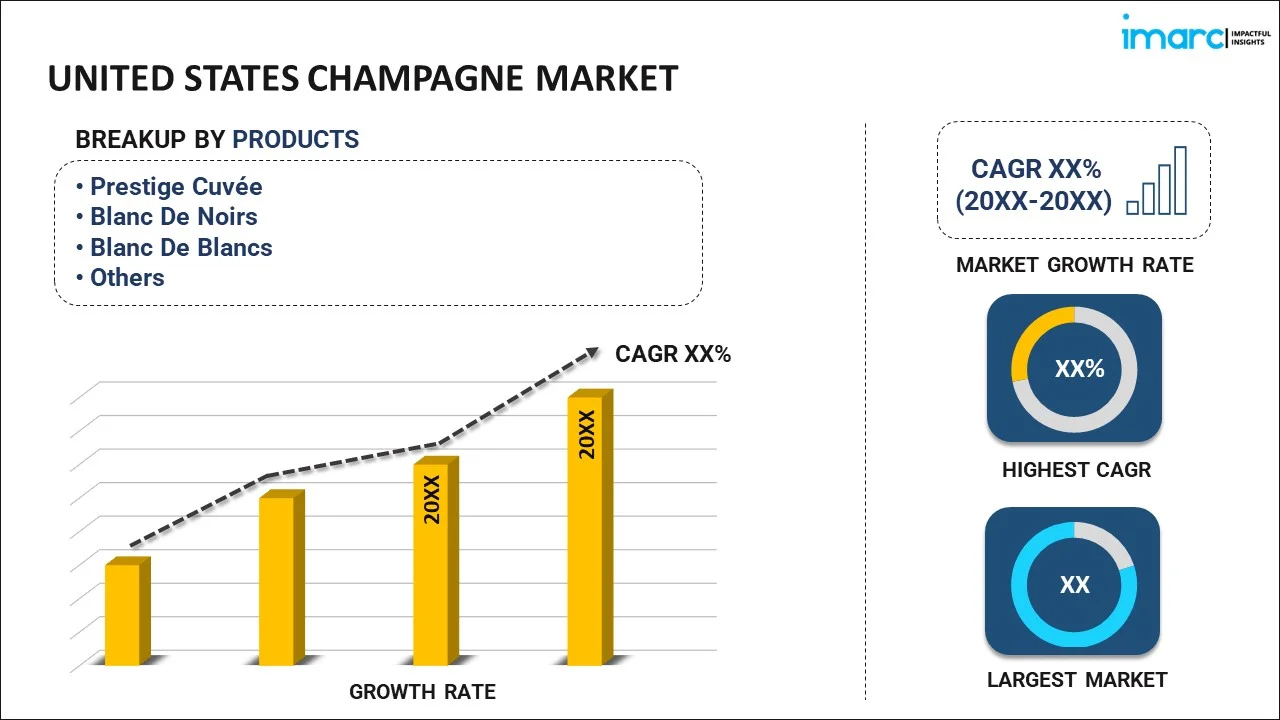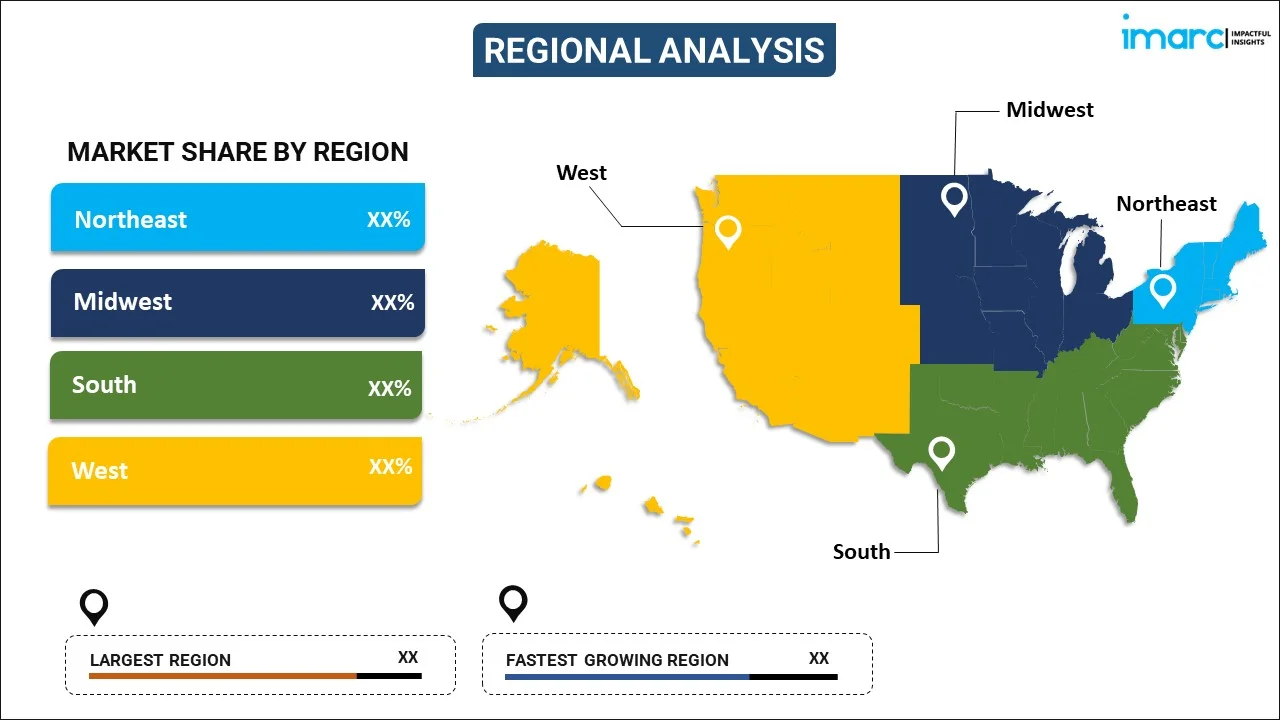
United States Champagne Market Report by Product (Prestige Cuvée, Blanc De Noirs, Blanc De Blancs, Rosé Champagne, and Others), Price (Economy, Mid-Range, Luxury), Distribution Channel (Supermarket and Hypermarket, Specialty Stores, Online Stores), and Region 2025-2033
Market Overview:
The United States champagne market size reached USD 1.7 Billion in 2024. Looking forward, IMARC Group expects the market to reach USD 2.4 Billion by 2033, exhibiting a growth rate (CAGR) of 4.2% during 2025-2033. The increasing demand for premium quality champagne products, changing consumer preferences, rising disposable income, the growing popularity of social media platforms, and widespread adoption of champagne in anniversaries, events, and birthdays represent some of the key factors driving the market.
|
Report Attribute
|
Key Statistics
|
|---|---|
|
Base Year
|
2024 |
|
Forecast Years
|
2025-2033 |
|
Historical Years
|
2019-2024
|
| Market Size in 2024 | USD 1.7 Billion |
| Market Forecast in 2033 | USD 2.4 Billion |
| Market Growth Rate (2025-2033) | 4.2% |
United States Champagne Analysis:
- Key Market Drivers: Increased disposable income and premium lifestyle adoption lead to the United States champagne market growth. Expanding celebration culture, social media power, and luxury brand positioning accelerate market growth. Rising consumer propensity to pay for premium experiences and gifting culture contribute substantially to the consumption of champagne across the country.
- Key Market Trends: United States champagne market analysis indicates high preference for vintage and artisanal types. Online shopping channels become increasingly important with direct-to-consumer sales models. Organic production processes and sustainability initiatives appeal to eco-friendly consumers. Premium positioning strategies increase brand value and market differentiation substantially.
- Challenges: Consumer luxury product expenditure is affected by economic uncertainties and inflation. Distribution and pricing are impacted by supply chain disruptions. Alcohol marketing regulations restrict promotional activity. Competition from domestic sparkling wines is challenging the traditional positioning of champagne in the market.
- Opportunities: Online grocery retailing provides new distribution channels and customer reach opportunities. Increasing millennial and Gen Z consumer base offers untapped market segments. Event markets and corporate gifting markets offer great opportunity for growth. There is an opportunity to expand the United States champagne market share through strategic alliances and innovative marketing strategies.
Champagne is a sparkling wine that is renowned for its elegance, quality, and association with celebration. It is produced through a specific winemaking method known as the method champenoise or traditional method. It is produced primarily from three grape varieties such as Chardonnay, Pinot Noir, and Pinot Meunier which contribute unique characteristics to the final blend. Chardonnay provides freshness, finesse, and citrus flavors, while Pinot Noir adds body, structure, and red fruit notes. On the other hand, Pinot Meunier contributes a fruity and approachable quality to the wine. It is often associated with special occasions and is a popular choice for toasting and celebrations and has a reputation for luxury and is considered a symbol of prestige and refinement. The production process of champagne involves two fermentation stages. Initially, the base wine is created through the first fermentation, which converts grape juice into still wine. Then, a second fermentation occurs inside the bottle, wherein a mixture of yeast and sugar, known as the liqueur de tirage, is added to the base wine, causing a secondary fermentation that produces carbon dioxide, resulting in characteristic bubbles. The wine ages on its lees, developing complex flavors and aromas before the sediment is removed through a process called disgorgement. As a result, champagne with its effervescence, delicate flavors, and unique production process is gaining immense popularity across the globe.
United States Champagne Market Trends:
Shifting Consumer Preferences and Premiumization
The U.S. champagne market is being strongly driven by changing consumer lifestyles and evolving preferences. Premium goods that enhance experiences and convey refinement and status are becoming more and more sought after by contemporary consumers. Champagne is a popular choice for celebratory events like weddings, birthdays, anniversaries, and significant life events because it has become a symbol of luxury. This demand is being further fueled by rising disposable incomes and a growing willingness to spend money on luxuries. Customers view champagne as a symbol of elegance and prestige in addition to being a beverage. This has resulted in increased demand from a variety of demographics, ranging from wealthy purchasers sticking to established spending patterns to younger consumers adopting aspirational lives. Collectively, these factors reinforce champagne’s image as an essential luxury product, positioning the U.S. market for steady growth in the premium and ultra-premium segments.
Socializing, Gifting, and Experiential Consumption
Another significant United States champagne market trend is the culture of socializing and gifting. Champagne is deeply associated with toasting, celebration, and commemorating meaningful occasions, which makes it an ideal gift for birthdays, anniversaries, weddings, and corporate milestones. The tradition of gifting champagne conveys appreciation, elegance, and sophistication, thereby driving consistent demand for premium and even personalized bottles. This trend is further amplified by the rise of corporate gifting practices and the growing preference for meaningful luxury experiences. Additionally, the gifting culture has encouraged champagne producers to innovate with packaging, limited editions, and bespoke customization options to attract consumers seeking exclusivity. The experiential value of champagne aligns seamlessly with its symbolic role in marking memorable moments, reinforcing its status as a cultural mainstay and significantly boosting demand across diverse consumer segments.
Influence of Social Media and Lifestyle Aspirations
The rapid rise of social media platforms such as Instagram, TikTok, and YouTube has created a visually driven culture that positions champagne as a luxury lifestyle symbol. The digital portrayal of champagne in glamorous settings—celebrations, nightlife events, or influencer content—has strengthened its aspirational value among younger consumers. Online exposure not only highlights champagne as a beverage but also as a marker of sophistication, wealth, and achievement. This cultural shift is boosting demand among millennials and Gen Z, who are highly influenced by visual storytelling and experiential marketing. Moreover, the growing interest in wine and spirits culture, fueled by digital education and online communities, is accelerating champagne adoption. As consumers increasingly look to emulate luxury lifestyles showcased online, champagne brands gain a unique opportunity to expand their presence and reinforce their premium positioning in the U.S. market.
Key Market Segmentation:
IMARC Group provides an analysis of the key trends in each segment of the United States champagne market report, along with forecasts at the country level from 2025-2033. Our report has categorized the market based on product, price, and distribution channel.
Breakup by Product:

To get more information on this market, Request Sample
- Prestige Cuvée
- Blanc De Noirs
- Blanc De Blancs
- Rosé Champagne
- Others
The report has provided a detailed breakup and analysis of the United States champagne market based on the product. This includes prestige cuvée, blanc de noirs, blanc de blancs, rosé champagne, and others.
Breakup by Price:
- Economy
- Mid-Range
- Luxury
The report has provided a detailed breakup and analysis of the United States champagne market based on the price. This includes economy, mid-range, and luxury.
Breakup by Distribution Channel:
- Supermarket and Hypermarket
- Specialty Stores
- Online Stores
A detailed breakup and analysis of the United States champagne market based on the distribution channel has also been provided in the report. This includes supermarkets and hypermarkets, specialty stores and online stores.
Regional Insights:

- Northeast
- Midwest
- South
- West
The report has also provided a comprehensive analysis of all the major regional markets, which include the Northeast, Midwest, South, and West.
Competitive Landscape:
The report has also provided a comprehensive analysis of the competitive landscape in the United States champagne market. Competitive analysis such as market structure, key player positioning, top winning strategies, competitive dashboard, and company evaluation quadrant has been covered in the report. Also, detailed profiles of all major companies have been provided.
Recent News and Development:
- In May 2025, Champagne de Lossy, a 19th-century brand revived after decades, is launching amid industry downturn and U.S. tariff threats. Following a €20 million investment—including a chateau, cellars, and promotion via a custom Rolls-Royce Droptail—the brut bottles will retail at about €300 in Riviera wine shops before expanding to the U.S., Asia, and Europe. Despite falling shipments and looming trade levies, the brand bets on luxury appeal and global demand.
- In April 2025, Champagne Telmont launched the world’s first ultra-lightweight standard champagne bottle in the U.S., weighing just 800g. Developed with Verallia, the eco-friendly design cuts carbon emissions by 4% per bottle without compromising strength or elegance. As bottles begin retailing with Telmont’s Réserve Brut, the brand plans full adoption from 2025, aiming to set a new sustainable standard for Champagne production and reduce the industry’s overall carbon footprint.
United States Champagne Report Coverage:
| Report Features | Details |
|---|---|
| Base Year of the Analysis | 2024 |
| Historical Period | 2019-2024 |
| Forecast Period | 2025-2033 |
| Units | Billion USD |
| Scope of the Report | Exploration of Historical and Forecast Trends, Industry Catalysts and Challenges, Segment-Wise Historical and Predictive Market Assessment:
|
| Products Covered | Prestige Cuvée, Blanc De Noirs, Blanc De Blancs, Rosé Champagne, Others |
| Prices Covered | Economy, Mid-Range, Luxury |
| Distribution Channels Covered | Supermarket And Hypermarket, Specialty Stores, Online Stores |
| Regions Covered | Northeast, Midwest, South, and West |
| Customization Scope | 10% Free Customization |
| Post-Sale Analyst Support | 10-12 Weeks |
| Delivery Format | PDF and Excel through Email (We can also provide the editable version of the report in PPT/Word format on special request) |
Key Benefits for Stakeholders:
- IMARC’s report offers a comprehensive quantitative analysis of various market segments, historical and current market trends, market forecasts, and dynamics of the United States champagne market from 2019-2033.
- The research study provides the latest information on the market drivers, challenges, and opportunities in the United States champagne market.
- Porter's five forces analysis assist stakeholders in assessing the impact of new entrants, competitive rivalry, supplier power, buyer power, and the threat of substitution. It helps stakeholders to analyze the level of competition within the United States champagne industry and its attractiveness.
- Competitive landscape allows stakeholders to understand their competitive environment and provides an insight into the current positions of key players in the market.
Key Questions Answered in This Report
The champagne market in the United States was valued at USD 1.7 Billion in 2024.
The United States champagne market is projected to exhibit a CAGR of 4.2% during 2025-2033, reaching a value of USD 2.4 Billion by 2033.
The market is driven by increasing demand for premium quality champagne products, changing consumer preferences, rising disposable income, growing popularity of social media platforms, and widespread adoption of champagne in anniversaries, events, and birthdays representing key growth factors.
Need more help?
- Speak to our experienced analysts for insights on the current market scenarios.
- Include additional segments and countries to customize the report as per your requirement.
- Gain an unparalleled competitive advantage in your domain by understanding how to utilize the report and positively impacting your operations and revenue.
- For further assistance, please connect with our analysts.
 Request Customization
Request Customization
 Speak to an Analyst
Speak to an Analyst
 Request Brochure
Request Brochure
 Inquire Before Buying
Inquire Before Buying




.webp)




.webp)












